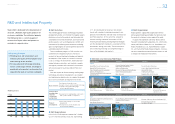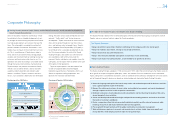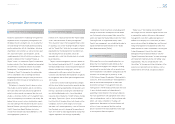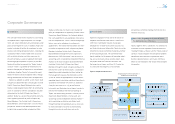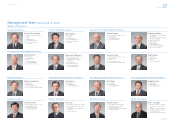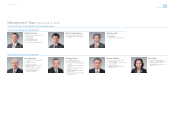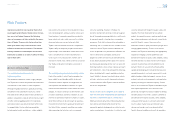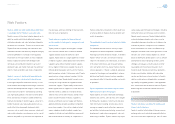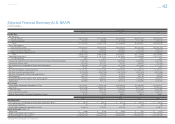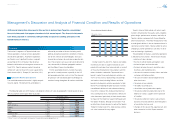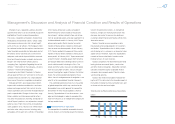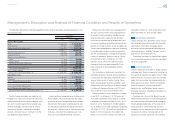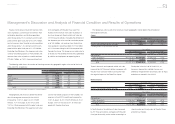Toyota 2013 Annual Report Download - page 41
Download and view the complete annual report
Please find page 41 of the 2013 Toyota annual report below. You can navigate through the pages in the report by either clicking on the pages listed below, or by using the keyword search tool below to find specific information within the annual report.
Toyota Global Vision President’s Message Launching a New Structure Special Feature Review of Operations
Consolidated Performance
Highlights
Management and
Corporate Information Investor InformationFinancial Section
Page 41
NextPrev
ContentsSearchPrint
ANNUAL REPORT 2013
Risk Factors
metals, non-ferrous alloys including aluminum, and
plastic parts, may lead to higher production costs for
parts and components. This could, in turn, negatively
impact Toyota’s future profi tability because Toyota may
not be able to pass all those costs on to its customers
or require its suppliers to absorb such costs.
The downturn in the fi nancial markets could
adversely affect Toyota’s ability to raise capital.
Should the world economy suddenly deteriorate, a
number of fi nancial institutions and investors will face
diffi culties in providing capital to the fi nancial markets at
levels corresponding to their own fi nancial capacity,
and, as a result, there is a risk that companies may not
be able to raise capital under terms that they would
expect to receive with their creditworthiness. If Toyota is
unable to raise the necessary capital under appropriate
conditions on a timely basis, Toyota’s fi nancial condition
and results of operations may be adversely affected.
쏋 Political, Regulatory, Legal and Other Risks
The automotive industry is subject to various
governmental regulations.
The worldwide automotive industry is subject to vari-
ous laws and governmental regulations including
those related to vehicle safety and environmental
matters such as emission levels, fuel economy, noise
and pollution. In particular, automotive manufacturers
and the euro and, to a lesser extent, the Australian
dollar, the Russian ruble, the Canadian dollar and the
British pound. Toyota’s consolidated fi nancial state-
ments, which are presented in Japanese yen, are
affected by foreign currency exchange fl uctuations
through translation risk, and changes in foreign
currency exchange rates may also affect the price of
products sold and materials purchased by Toyota in
foreign currencies through transaction risk. In particu-
lar, strengthening of the Japanese yen against the U.S.
dollar can have an adverse effect on Toyota’s
operating results.
Toyota believes that its use of certain derivative
fi nancial instruments including foreign exchange
forward contracts and interest rate swaps and
increased localized production of its products have
reduced, but not eliminated, the effects of interest rate
and foreign currency exchange rate fl uctuations.
Nonetheless, a negative impact resulting from fl uctua-
tions in foreign currency exchange rates and changes
in interest rates may adversely affect Toyota’s fi nancial
condition and results of operations.
High prices of raw materials and strong pressure
on Toyota’s suppliers could negatively impact
Toyota’s profi tability.
Increases in prices for raw materials that Toyota and
Toyota’s suppliers use in manufacturing their products
or parts and components such as steel, precious
such as Toyota are required to implement safety
measures such as recalls for vehicles that do not or
may not comply with the safety standards of laws and
governmental regulations. In addition, Toyota may, in
order to reassure its customers of the safety of
Toyota’s vehicles, decide to voluntarily implement
recalls or other safety measures even if the vehicle
complies with the safety standards of relevant laws
and governmental regulations. Many governments
also impose tariffs and other trade barriers, taxes and
levies, or enact price or exchange controls. Toyota has
incurred, and expects to incur in the future, signifi cant
costs in complying with these regulations. If Toyota
launches products that result in safety measures such
as recalls, Toyota may incur various costs including
signifi cant costs for free repairs. Furthermore, new
legislation or changes in existing legislation may also
subject Toyota to additional expenses in the future. If
Toyota incurs signifi cant costs related to implementing
safety measures or meeting laws and governmental
regulations, Toyota’s fi nancial condition and results of
operations may be adversely affected.
Toyota may become subject to various legal
proceedings.
As an automotive manufacturer, Toyota may become
subject to legal proceedings in respect of various
issues, including product liability and infringement of
intellectual property. Toyota may also be subject to
legal proceedings brought by its shareholders and
governmental proceedings and investigations. Toyota
is in fact currently subject to a number of pending legal
proceedings and government investigations. A nega-
tive outcome in one or more of these pending legal
proceedings could adversely affect Toyota’s fi nancial
condition and results of operations.
Toyota may be adversely affected by natural
calamities, political and economic instability, fuel
shortages or interruptions in social infrastructure,
wars, terrorism and labor strikes.
Toyota is subject to various risks associated with
conducting business worldwide. These risks include
natural calamities; political and economic instability;
fuel shortages; interruption in social infrastructure
including energy supply, transportation systems, gas,
water, or communication systems resulting from natu-
ral hazards or technological hazards; wars; terrorism;
labor strikes; and work stoppages. Should the major
markets in which Toyota purchases materials, parts
and components and supplies for the manufacture of
Toyota products or in which Toyota’s products are
produced, distributed or sold be affected by any of
these events, it may result in disruptions and delays in
the operations of Toyota’s business. Should signifi cant
or prolonged disruptions or delays related to Toyota’s
business operations occur, it may adversely affect
Toyota’s fi nancial condition and results of operations.
R&D and Intellectual Property Corporate Philosophy Corporate Governance Management Team Risk Factors [3 of 3]



